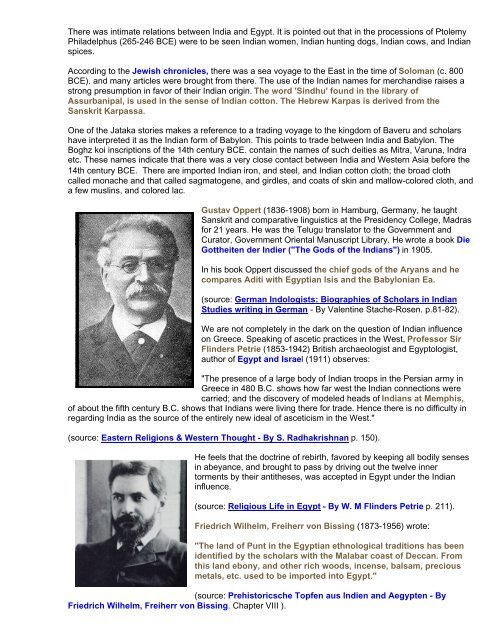A Tribute to Hinduism - India and Egypt - Mandhata Global
A Tribute to Hinduism - India and Egypt - Mandhata Global
A Tribute to Hinduism - India and Egypt - Mandhata Global
You also want an ePaper? Increase the reach of your titles
YUMPU automatically turns print PDFs into web optimized ePapers that Google loves.
There was intimate relations between <strong>India</strong> <strong>and</strong> <strong>Egypt</strong>. It is pointed out that in the processions of P<strong>to</strong>lemy<br />
Philadelphus (265-246 BCE) were <strong>to</strong> be seen <strong>India</strong>n women, <strong>India</strong>n hunting dogs, <strong>India</strong>n cows, <strong>and</strong> <strong>India</strong>n<br />
spices.<br />
According <strong>to</strong> the Jewish chronicles, there was a sea voyage <strong>to</strong> the East in the time of Soloman (c. 800<br />
BCE). <strong>and</strong> many articles were brought from there. The use of the <strong>India</strong>n names for merch<strong>and</strong>ise raises a<br />
strong presumption in favor of their <strong>India</strong>n origin. The word 'Sindhu' found in the library of<br />
Assurbanipal, is used in the sense of <strong>India</strong>n cot<strong>to</strong>n. The Hebrew Karpas is derived from the<br />
Sanskrit Karpassa.<br />
One of the Jataka s<strong>to</strong>ries makes a reference <strong>to</strong> a trading voyage <strong>to</strong> the kingdom of Baveru <strong>and</strong> scholars<br />
have interpreted it as the <strong>India</strong>n form of Babylon. This points <strong>to</strong> trade between <strong>India</strong> <strong>and</strong> Babylon. The<br />
Boghz koi inscriptions of the 14th century BCE. contain the names of such deities as Mitra, Varuna, Indra<br />
etc. These names indicate that there was a very close contact between <strong>India</strong> <strong>and</strong> Western Asia before the<br />
14th century BCE. There are imported <strong>India</strong>n iron, <strong>and</strong> steel, <strong>and</strong> <strong>India</strong>n cot<strong>to</strong>n cloth; the broad cloth<br />
called monache <strong>and</strong> that called sagma<strong>to</strong>gene, <strong>and</strong> girdles, <strong>and</strong> coats of skin <strong>and</strong> mallow-colored cloth, <strong>and</strong><br />
a few muslins, <strong>and</strong> colored lac.<br />
Gustav Oppert (1836-1908) born in Hamburg, Germany, he taught<br />
Sanskrit <strong>and</strong> comparative linguistics at the Presidency College, Madras<br />
for 21 years. He was the Telugu transla<strong>to</strong>r <strong>to</strong> the Government <strong>and</strong><br />
Cura<strong>to</strong>r, Government Oriental Manuscript Library. He wrote a book Die<br />
Gottheiten der Indier ("The Gods of the <strong>India</strong>ns") in 1905.<br />
In his book Oppert discussed the chief gods of the Aryans <strong>and</strong> he<br />
compares Aditi with <strong>Egypt</strong>ian Isis <strong>and</strong> the Babylonian Ea.<br />
(source: German Indologists: Biographies of Scholars in <strong>India</strong>n<br />
Studies writing in German - By Valentine Stache-Rosen. p.81-82).<br />
We are not completely in the dark on the question of <strong>India</strong>n influence<br />
on Greece. Speaking of ascetic practices in the West, Professor Sir<br />
Flinders Petrie (1853-1942) British archaeologist <strong>and</strong> Egyp<strong>to</strong>logist,<br />
author of <strong>Egypt</strong> <strong>and</strong> Israel (1911) observes:<br />
"The presence of a large body of <strong>India</strong>n troops in the Persian army in<br />
Greece in 480 B.C. shows how far west the <strong>India</strong>n connections were<br />
carried; <strong>and</strong> the discovery of modeled heads of <strong>India</strong>ns at Memphis,<br />
of about the fifth century B.C. shows that <strong>India</strong>ns were living there for trade. Hence there is no difficulty in<br />
regarding <strong>India</strong> as the source of the entirely new ideal of asceticism in the West."<br />
(source: Eastern Religions & Western Thought - By S. Radhakrishnan p. 150).<br />
He feels that the doctrine of rebirth, favored by keeping all bodily senses<br />
in abeyance, <strong>and</strong> brought <strong>to</strong> pass by driving out the twelve inner<br />
<strong>to</strong>rments by their antitheses, was accepted in <strong>Egypt</strong> under the <strong>India</strong>n<br />
influence.<br />
(source: Religious Life in <strong>Egypt</strong> - By W. M Flinders Petrie p. 211).<br />
Friedrich Wilhelm, Freiherr von Bissing (1873-1956) wrote:<br />
"The l<strong>and</strong> of Punt in the <strong>Egypt</strong>ian ethnological traditions has been<br />
identified by the scholars with the Malabar coast of Deccan. From<br />
this l<strong>and</strong> ebony, <strong>and</strong> other rich woods, incense, balsam, precious<br />
metals, etc. used <strong>to</strong> be imported in<strong>to</strong> <strong>Egypt</strong>."<br />
(source: Prehis<strong>to</strong>ricsche Topfen aus Indien <strong>and</strong> Aegypten - By<br />
Friedrich Wilhelm, Freiherr von Bissing. Chapter VIII ).

















